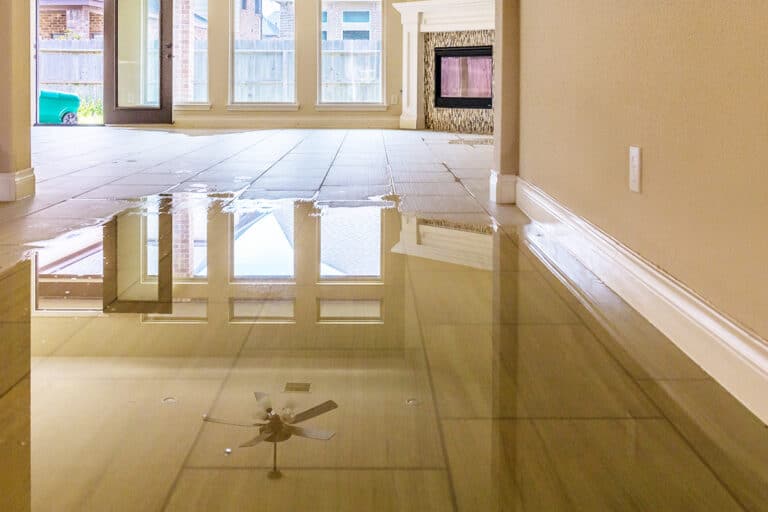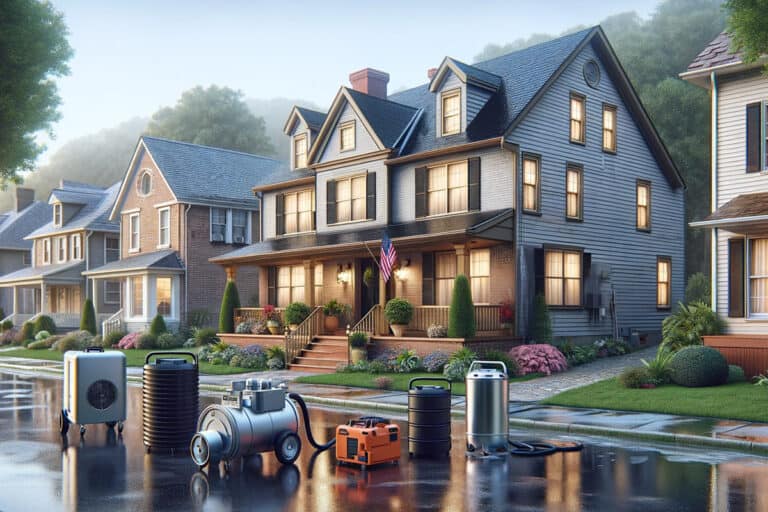Disclosure: I am compensated for purchases made through some links on this site. Click for details.
Mold on ceilings is a common and concerning issue in many households due to its potential to cause health and respiratory problems. It’s often a symptom of excess moisture or water damage and may lead to unsightly stains and damage to your home. Understanding how to properly remove mold from your ceiling is crucial in maintaining a healthy living environment and preventing further damage.
Before attempting to clean the mold, it is essential to identify the cause of the growth and take proper measures to prevent it from returning. Moisture control is the key to mold prevention, so addressing any underlying issues such as leaks or poor ventilation is just as important as the cleaning process itself.
When removing mold from the ceiling, safety should be your top priority. Using the appropriate cleaning solutions and protective gear ensures that the mold is effectively eradicated without causing harm to yourself or others. Once cleaned, regular inspections and maintenance can help keep your ceilings mold-free.
Key Takeaways
- Mold on ceilings can be harmful to health and should be addressed promptly.
- Identifying and resolving the moisture source is essential in preventing mold recurrence.
- Proper safety measures and consistent maintenance are crucial in effective mold removal.
Understanding Mold on the Ceiling
Mold on the ceiling is a common household problem that can pose significant health and safety concerns. Addressing the causes, identifying the types of ceiling mold, and understanding the potential health implications are crucial for effective remediation.
Causes of Mold Growth
Ceiling mold typically arises from excess moisture and high humidity levels within a space. Common contributing factors include:
- Leaks: A leaking roof or plumbing issues that introduce water into ceiling materials.
- Condensation: Occurs when warm, humid air contacts a cold surface, such as in poorly ventilated or insulated spaces.
- Poor Ventilation: Spaces like bathrooms without adequate airflow encourage mold growth due to stagnant moist air.
For instance, inadequate insulation in the attic may lead to condensation on the underside of the roof, creating a prime environment for mold.
Types of Ceiling Mold
There are several types of mold that can appear on ceilings, with colors ranging from black to green:
- Black Mold: Known for its dark appearance and potential to cause respiratory problems.
- Green or Brown Mold: Typically less harmful, but still require removal to prevent spread and structural damage.
Each type may have different removal and mold remediation methods.
Health and Safety Concerns
Mold exposure, especially to types like black mold, can have serious health risks, including:
- Allergies: Mold spores can trigger allergic reactions and symptoms such as sneezing and itchy eyes.
- Respiratory Issues: Prolonged exposure can lead to more severe respiratory problems.
For safety, it is important to properly assess and address mold using the appropriate remediation techniques.
Preparation for Mold Removal
Before one begins the process of mold removal from the ceiling, it’s critical they take the necessary safety precautions and identify the sources of moisture that have contributed to the mold growth. Addressing these issues first ensures a safer work environment and a more effective cleanup.
Safety Measures
Individuals must equip themselves with the appropriate safety gear to prevent inhaling spores or coming into contact with mold. Essential protective gear includes:
- Gloves: to avoid direct skin contact with mold.
- Mask: a high-quality N-95 respirator is recommended to filter out mold spores.
- Eye Protection: goggles without ventilation holes to protect the eyes.
- Protective Clothing: ideally disposable, to cover skin and prevent mold spore contamination.
Proper ventilation is also necessary to disperse mold spores and fumes from cleaning agents. Opening windows and using fans helps maintain good airflow during the mold removal process.
Identifying and Repairing Moisture Sources
Mold on ceilings is typically due to excess moisture, which must be located and rectified before mold removal begins. Common moisture sources to consider are:
- Leaks: Check for and repair any roof leaks or plumbing failures.
- Condensation: Often found in areas with poor ventilation or insulation.
Identifying the source of moisture is a critical step. Failure to repair it will likely result in mold returning in the future. It may be necessary to consult a professional if the moisture source is not obvious or easy to fix.
Practical Mold Removal Techniques
When dealing with mold on the ceiling, it’s vital to choose the right approach for effective remediation. One can opt for natural solutions that are less abrasive or use chemical treatments for tougher mold problems. It is important to prepare the area by laying down plastic sheets and ensuring good ventilation.
Natural Cleaning Solutions
For a safer, environmentally-friendly method, individuals often turn to natural cleaning agents. One can create a mold-killing solution with one tablespoon of tea tree oil mixed with one cup of water. Another effective natural cleaner is vinegar, which can be applied directly to the moldy area. A baking soda solution or a mixture of borax and water can also be used to scrub away mold without the harsh fumes associated with chemicals.
Chemical Mold Remediation
Sometimes, more persistent mold may necessitate the use of stronger chemical mold killers. Preparing a solution with one part bleach to four parts water is commonly recommended for eliminating mold. One should apply the mixture with a clean cloth or a squeegee for a controlled application. For wooden surfaces, a 3% hydrogen peroxide solution can be applied to the affected area, letting the wood absorb it before scrubbing.
Detailed Cleaning Procedures
A meticulous approach is crucial to thoroughly eradicate mold. Start by suiting up with appropriate protective gear. A boric acid spray can be used for targeting specific spots. After applying your chosen cleaning solution, let it sit to break down the mold, then vigorously wipe the area with a clean cloth to remove any residual spores. For stubborn mold, repeat the application as necessary, always ensuring the area is completely dry to prevent further mold growth.
Post-Removal Process
After mold remediation, verifying the thoroughness of the cleanup and implementing strategies to avert future occurrences is crucial. The focus now turns to ensuring complete removal and taking measures to prevent mold from returning.
Ensuring Complete Removal
It is paramount to conduct mold testing post-removal to establish that all mold on the ceiling has indeed been eradicated, especially within porous materials where mold spores can thrive unseen. A certified professional can provide a comprehensive inspection to confirm that no residual mold stains or colonies remain. This step is essential, as any overlooked mold can regrow and spread.
Preventing Future Mold Growth
Maintaining a well-ventilated space is key in preventing future mold growth. Use of dehumidifiers and ensuring adequate airflow with exhaust fans in moisture-prone areas like bathrooms and kitchens can help regulate humidity levels. Regular inspections of these areas for any signs of mold can catch new growth early, making it easier to address swiftly.
Professional Mold Remediation
When dealing with mold growth, certain situations necessitate the expertise of a professional mold remediation company. These services ensure the structural integrity of the property and the health of its occupants.
When to Hire a Professional
One should consider hiring a professional when the mold covers a large area, if it is in the HVAC system, or if someone in the home has health issues that could be worsened by exposure to mold. Mold can undermine structural integrity, making it crucial to involve experts who can assess and address extensive damage reliably.
What to Expect from Expert Services
Professional remediation services perform a comprehensive assessment to identify the full scope of the mold infestation. They then create a customized treatment plan which typically includes:
- Containment and Ventilation: This prevents spores from spreading during the cleanup.
- Air Filtration: Experts use HEPA filters to clean the air of spores.
- Removal and Cleaning: Infected materials are removed; remaining surfaces are cleaned with specialized agents.
A professional mold remediation service provides thorough cleanup and suggests measures to prevent future mold growth, ensuring a safe and clean living environment.
Additional Considerations
When removing mold from ceilings, it’s important to not only treat the visible problem but also to address underlying issues that could lead to future growth and potential structural damage. Consider the surface type, related home maintenance, and indoor air quality during the remediation process.
Handling Porous Surfaces and Materials
On porous surfaces, such as drywall or textured ceilings, mold can penetrate below the surface, making it challenging to remove completely. When painting over mold, it’s crucial to first kill the organism with an appropriate cleaning solution; otherwise, regrowth is likely. Materials like ceiling tiles may need to be replaced if the mold infestation is severe, as the roots can embed deep within the product.
Addressing Related Home Maintenance Issues
Mold often indicates a moisture source such as leaks or high humidity that requires attention. Peeling paint or ghosting, which are discolored streaks or spots, can signify moisture problems. To prevent future mold issues, homeowners should repair any structural damage and ensure proper ventilation in moisture-prone areas like bathrooms.
Improving Indoor Air Quality
Maintaining good indoor air quality is essential in the fight against mold. Proper ventilation reduces moisture, limiting mold growth. In a bathroom, for instance, an exhaust fan can help to expel damp air, while using a dehumidifier in other parts of the home can keep humidity levels in check. Addressing these factors plays a role not just in eradicating existing mold but also in safeguarding the home against future outbreaks.
Conclusion
Mold presence on ceilings is both a health concern and a structural issue. The key to managing this problem lies in quick and effective removal, followed by preventive measures to ensure it does not return. Homeowners can typically handle small patches of mold by using simple cleaning solutions such as hydrogen peroxide or vinegar and adopting thorough drying practices.
For persistent or large infestations, it is crucial they seek professional assistance to address the cause and safely remove the mold. They should also consider improving ventilation and controlling humidity levels in the affected areas. By regularly inspecting ceilings for signs of mold, homeowners can prevent the spread and safeguard their residential environment.
Regular maintenance is essential, as mold-resistant materials can offer long-term protection against potential growth. One should replace any damaged ceiling tiles and ensure that bathrooms, in particular, have adequate exhaust fans. It’s imperative to maintain these practices to create a mold-resistant home.



